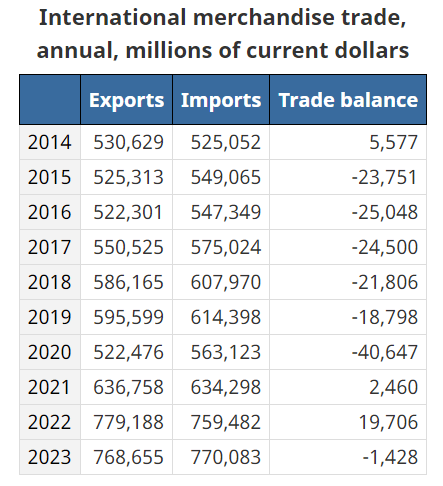In Canada’s trade in 2023, product exports recorded a year-on-year drop of 1.4 percent, while imports grew 1.4 percent.
Consequently, exports declined to C$768.655 million and imports increased to C$770.082.
Also, Canada’s merchandise trade balance with the world went from a surplus of C$19,706 million in 2022 to a deficit of C$1,428 million in 2023.

The increase in imports in 2023 was largely due to a sharp increase in imports of motor vehicles and parts (+19.5 percent), while the drop in exports was due to a large decline in exports of energy products (-18.9 percent).
Canada’s trade
In terms of trade activity, Canada’s total merchandise trade (imports plus exports) was essentially unchanged in 2023, standing at $1.5 trillion for the second consecutive year.
According to EDC, Canada’s economy will slow this year as high interest rates continue to weigh on over-indebted households and drag down business spending.
Weaker external demand will also contribute to Canada’s overall economic outlook, as EDC forecasts Gross Domestic Product (GDP) to fall to 0.8% in 2024 before recovering to 2% in 2025.
Demographics
Cooling labor markets, high borrowing costs and a less enthusiastic consumer will foreseeably make for a dismal spending period in 2024.
The Canadian consumer is expected to dig in until inflation and interest rates decline.
Canada’s growing population has increased the supply of labor for businesses and is likely to drag on wage growth this year, which will contribute to a drag on household purchasing power.
While businesses are less concerned about labor shortages due to the large influx of new immigrants, slowing consumer demand will dampen business investment spending.
However, the slowdown in business investment is unlikely to translate into massive layoffs, as the economic malaise is expected to be short-lived.

